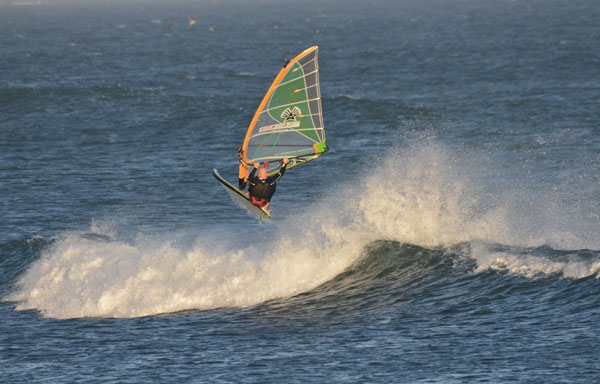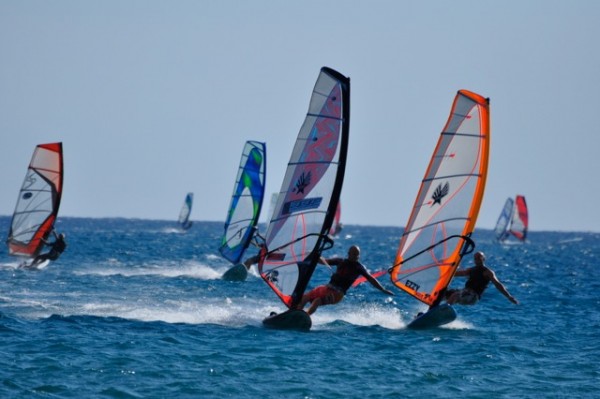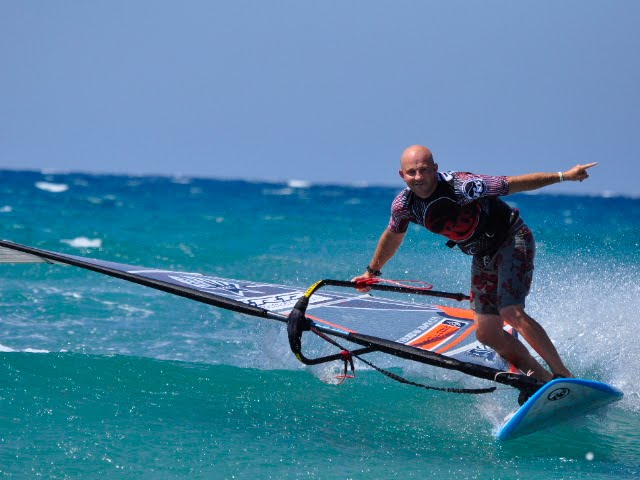Over to Jem Hall, our technique guru, to see what he has to say in his new series of articles examining a multitude of windsurfing skills and techniques and aptly named ‘The Moves That Matter.’ This time round Jem highlights the links from your fundamentals to how these help you wave ride a FSW and as ever continues to inspire, educate, entertain and enthuse you to take your sailing up a level.

I hope you enjoyed my first article on my new technique series, the Moves That Matter (MTM), and you can check here for a recap should you so wish. As I have now set out my stall, so to speak, I wish to cover how to go about wave riding on a freestyle wave (FSW) board and more in terms of a rough guide and tuning tips than a step-by-step how to. This is because as we are in winter (unless you are reading this at another time) you are best served to be using visualisation and target setting in order to put a rocket up the backside of your sailing for 2012. Visualise what you WILL be doing on the water and then add the heavily required ingredients of dedication and perspiration as your season and sailing sessions kick off in the spring.
I have already coined a phrase with you in that you can move from ‘Beginner to Winner,’ and mainly when you become brilliant at your basics. It is no mistake that the people on my clinics who progress the fastest in the waves put in the most work on flat water and look efficient and effective in this environment, with this in mind I strongly push people to do flat water clinics before wave clinics – no matter their level. Therefore I will be using this article to not only highlight how to rip it up on a FSW, but also demonstrate how the key parts in actually achieving this are hugely connected to your fundamentals.
FSW Sailing
We touched upon the key areas / skills in the last article of what I will be covering in my ‘Moves that Matter’ series and now let me show you the cross over these individual skills have. Please understand that the reason I am doing this is to entice the more advanced sailors to have a more complete strategy of how to achieve wave sailing nirvana and also to demonstrate to improver/intermediate sailors that their journey to becoming competent at wavesailing has already started and add more fuel to the fires that motivate them to keep at it.
Start – When you wave sail you will be required water starts in light/marginal and super overpowered winds so ensure you get up and out efficiently. Failure to get out of the water quickly in order to get on a ‘set’ wave following a wet tack or gybe can often mean missing out an invaluable wave ride.
Holy Trinity – 3 areas, getting upwind (faster and/or more efficiently), planing early (in a variety of wind strengths) and sailing fast. If you cannot get upwind, you have less opportunity to wave ride downwind. Planing early will get you up and moving and give you more of a chance to get over the incoming waves and it will also mean you can catch more waves on the way in. Sailing fast means you are more mobile on the way out so you have extra routes to choose from and on the way in you can actually catch and keep on those damn waves.

Tack – Swear word I know and I will put another pound in the swear box but if you tack you stay upwind and therefore can catch more waves in, and have more choices on the way out too. I tack 2 or 3 times more than I gybe when I am wavesailing and on clinics the tackers get 3 times as many set waves as the non tackers.
Gybe – Having a smooth and consistent gybe will coach you in the all areas you need to wave ride, including rig positioning, co-ordination of the hands and head and understanding the subtleties of shifting weight between the back and the front foot. How you gybe is you wave ride.

Carving moves – Working on these in all winds helps you understand how better to connect with a carving rail and understand your relationship with both it and the rig.
Jumping – sometimes you have to make efficient /preferably planing jumps on the way out or you will not get out the back and will therefore miss out on lots of fun and invaluable riding experiences. Chop hops and pops and planing out of them can be done twice per reach in order to gain competency both ways so you can sail on both tacks.

Of course, you will learn so much more on one of my fine coaching clinics as you can get all this live, instant and direct with the conditions to put it in place, pimping done now.
WAVE RIDING
Wave Riding – As I have said this is the best fun you can have ever! Either with or without a rig in planing and non-planing winds and on big (WindSUPS) or small boards (fsws, freemoves, wave boards – what ever). Next, we will look at the main tips for riding a FSW.
You may ask why I am covering wave riding on a FSW? Well, the reason is that many people who are looking to become more comfortable in coastal sailing have one and it might be their medium to medium large all rounder. It will be their workhorse and often is a great stepping-stone on the route down towards smaller and wavier shaped boards. The other reason I propose is that people may have them in their quiver of boards and choose to use them when the conditions are not so perfect or perhaps when the wind is lighter and gustier.

The FSW will get you up and planing and out the back with relative ease and make your transitions at either end easier. You can use its early planing, speed and upwind ability, in relation to a wave board, to get more waves under your belt. Where it can get let down is in its top end control when well powered up as they can become quite flighty. A FSW will also require you to turn more progressively and will not allow you to turn as tight as wave board nor with as much control, and definitely so in comparison to a multi finned wave board.
Lets look at what we can do to tune up our FSW to turn better. Before I do this I would like to advertise that I will be covering an article on tuning in the spring edition of the new most fabulous Boards Magazine.
FSW to wave rider – what to do in the pit lane:
Mast Foot – experiment with bringing the mast foot back. FSWs often have lower nose rocker than wave boards so this will lift the nose to aid dropping down waves and it will further aid tighter turning off the back foot.
Foot Straps size – get your head round this, the bigger the board you are wave riding the bigger the straps need to be! This is due to the requirement that you have to get as much right over either your toe side or heel side rail in order turn the beast. When just regular blasting you can edge your feet over to the windward rail in order to keep this relatively big boards locked down. Check out how far, both others, and my feet are through the straps!
Foot straps placement – in order get the board turning you have to sink the rail and tail somewhat and also (see Mast Foot position) lift the nose, therefore experiment with moving your front straps back and having your back foot strap (single strap please) as far back as possible for your stature. This means you can carve the board hard when required and facilitates your progression to become more aggressive.
Fin – downsize your fin from most probably its stock size of 28 – 30cms to a curvier wave shaped 23 – 25cms ripper. If you have a classic / US box then you can experiment with moving the fin more forward in its box to make the board looser.
As I said earlier this is to be general tips on how to wave ride a FSW, and for now mainly in frontside conditions, so lets look at these Jems of Knowledge now;
Bottom turn – start this from high up on the wave and aim to make your turn on the wave and definitely be initiating your carve at least 3 / 4 of the way down the wave face. Move your hands back down the boom as you drop into the turn, just like in a carve gybe, and gradually increase the pressure. On a FSW you will need to turn less off the front foot and more off the back foot, whilst doing this the nose is kept down by staying low, pushing the rig forward and pulling down on the boom, both through a straight front arm. The other requirement of a FSW is that you must turn more progressively, or as I say go through the gears slower.
Simple Tip – hands wide, look downwind and gradually turn off your toes.

Mid Part – this is the transition phase and is often the missing link in waveriding. Open the sail here and look for the top of the wave (the lip), as you would do when looking out of a gybe. This is when on a FSW you have to really really swing your hips across to the inside AND get your hips back, in relation the rig, as you carve hard.
Simple tip – Look at the lip and swing your hips across

Top Turn – Your hands were apart and now as you go up the wave your hands will come back together and turn your head to look forwards AND back down the wave, where you want to go. Shift your bodyweight outboard as you begin to weight the heelside and open the sail. On a FSW this needs to be done earlier, more progressively and with more force in order to move the wider outline and stiffer rocker of these boards.

Simple tip – Hands together, look forward and get outboards to push on your heels.

In summary, use your turns on the FSW to get into the flow of moving mainly your head and hands and then the rest of your body and rails and rig will follow. Set up your FSW to make it turnier, make your turns committed yet more gradual and more off the back foot.
‘Get on the wave, accept its energy, focus and charge with it.’ Bodhi in Point Break to Utah during their night surf, chesy but you got to love it.
More about Jem
If you seriously want to improve and have a fantastic holiday book on one of Jem’s coaching clinics NOW! For 2012 he kicks off with marvellous Marsa Alam in March, then magical Moulay in May, reliable Rhodes in summer, Beautiful Brandon Bay, Ireland in October and the pièces de résistance, PSC, Baja in August and Beautiful Brazil in November.
Jem’s brand new wave technique movie Winner to Wavesailor is ready to PURCHASE NOW, and for all your fundamentals he has Beginner to Winner. You can now buy all 3 movies, including Freestyle, in the Trilogy box set.
RRD boards, Ezzy Sails, Big Salty Weather, Flying Objects and Prosport Sunblock sponsor Jem Hall.
Check out jemhall.com for more details on all of the above.





